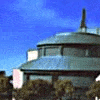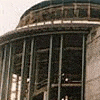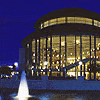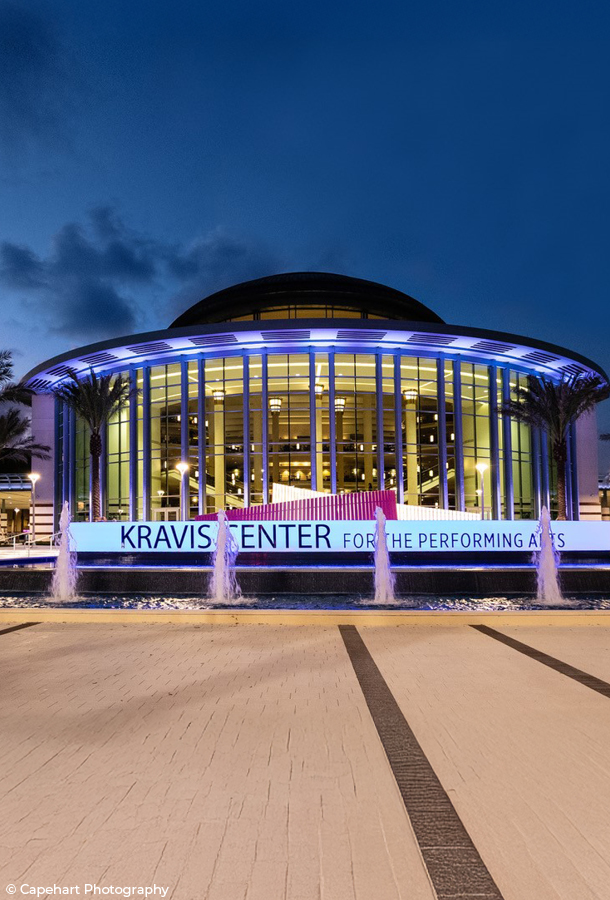History of the Kravis Center
The Seed of an Idea
A major performing arts facility had long been a dream of Palm Beach County residents. Efforts to build an arts center began here in the early 1950s. The first step in this direction came with the arrival of the Palm Beach Playhouse, later the Royal Poinciana Playhouse. In 1968, a local arts pioneer, Mary Howes, along with a group of other residents, formed Fine Arts Festival, Incorporated. They sponsored six benefits to raise funds to build an arts center that would accommodate major opera, orchestra, ballet, and theatrical productions. They got as far as commissioning the late architect John Volk to draft a model. A feasibility study was conducted, and land was optioned next to the current site of the West Palm Beach Auditorium. But it became apparent that the community was not yet ready to support such a major undertaking.
Early Efforts to Build the Center
Over the next ten years, the arts continued to grow in the county, and by 1978, the Palm Beach County Council of the Arts (later renamed the Palm Beach County Cultural Council) was created, largely as a result of the efforts of Alexander W. Dreyfoos, then chairman and president of Photo Electronics Corporation/WPEC TV-12, and Judy Goodman, an executive with Mr. Dreyfoos’ firm. One of the goals of the council was to explore the possibility of building a major performing arts center.
By 1980, the Arts Center Committee was actively pursuing the construction of an arts center financed solely with private funds. Although a site at Currie Park on Lake Worth in West Palm Beach had already been selected, the community was not yet ready to meet the financial challenge that the Center presented.
Initial efforts to secure public funding focused on a proposed county one cent sales tax referendum. Although the referendum was defeated, results showed that some thirty percent of voters had agreed to tax themselves to build a world-class performing arts center. These results were encouraging.
Getting It Built
In 1983, plans for the location of the Center had changed. Because of neighborhood opposition, Currie Park was no longer an option. Instead, planners switched their focus to a site adjacent to Palm Beach Community College in John Prince Park. The Center gathered $20 million in public commitments, but at this point at least another $5 million needed to be raised to build the Center. In 1985, Mr. Dreyfoos kicked off the private fundraising with a $1 million gift from Photo Electronics Corporation/WPEC TV-12. That same year the Center’s original Board of Directors was formed and included Alexander W. Dreyfoos, Jr., Merrill L. Bank, John J. Brogan, Thomas M. Chastain, Leonard Davis and Robert M. Montgomery, Jr. All members of the original Board had a long history of community involvement.
In 1986, a multimillion dollar contribution shifted fundraising efforts into high gear. A consortium of friends of Oklahoma native Raymond F. Kravis, led by Leonard Davis and Merrill Bank, agreed to raise $5 million in Mr. Kravis’ honor. Mr. Kravis, a prominent geologist and philanthropist, wintered in Palm Beach with his wife Bessie, and this gift served as a major catalyst to the private fundraising campaign and inspired the Center’s name. By the time the Center opened to the public in 1992, contributions in Mr. Kravis’ honor totaled over $10 million.
Leonard Davis and his wife, Sophie, had long been active supporters of the arts in New York and, when they relocated to Palm Beach County, they became a major force in the drive to build the Kravis Center. Mrs. Davis served as President of Regional Arts Foundation, which was founded by the Davises. To this day the Davises’ sponsorship continues to fund the popular MUSIC “At Eight” and MUSIC “At Two” Regional Arts Concert Series which bring major national and international artists in classical music to the Palm Beach County community. Mr. Davis sat on the Kravis Center’s Executive Committee as well as the Building and Grounds and Finance Committees.
Merrill Bank, also an original Board member, was a tireless fundraiser for the Kravis Center. He Co-Chaired the initial capital campaign along with Alex Dreyfoos, which raised the $9.2 million in private money. Mr. Bank served on the Center’s Development Committee along with John Brogan. He also served on the Finance Committee and was Secretary/Treasurer of the Center and Co-Chairman of the Advisory Board. His wife, Helen, was active in the Building Campaign advisory committee and remains a valued supporter of the Center.
A year long review of architects culminated in 1986 with the selection of world-renowned Canadian architect, Eberhard Zeidler of Toronto-based Zeidler-Roberts Partnership. As the community’s support for the Center grew, the scope and function of the facility that was originally envisioned expanded. The estimated cost for this new type of facility grew to $55 million. The community responded positively to this new plan, with Barnett Bank assembling a consortium of banks to offer a $17 million construction loan, backed by county issued Industrial Development Revenue Bonds.
It seemed that all was a go, and a ground breaking ceremony took place at the community college site. Just one month later, negotiations with the college came to a halt when it was learned that state regulations prohibited any debt financing to be used for the construction of facilities on community college campuses.
At this juncture, Henry Rolfs, Sr. offered a 5.4 acre parcel of prime downtown real estate as an alternative site. The land had been part of Downtown/Uptown, a large-scale private redevelopment project. In addition the city offered a $5 million contribution and long-term financing for the construction of the Center’s parking garage.
At this time, Blount, Inc., builder of the New Orleans Superdome as well as other major facilities, was chosen as the construction company that would build the Center. Blount began the 36 month construction schedule in September 1989. They were joined by New York-based Artec Consultants’ Russell Johnson, who designed the pristine acoustics of the main concert hall. In addition, Robert Metzger Interiors, also based in New York, brought a ’40s Moderne motif to everything from the carpeting and furniture to the colors of the marble.
Fundraising efforts proceeded beyond everyone’s most optimistic hopes, and by the summer of 1991, it was evident the center would likely achieve an unheard of goal–a fully funded opening. The accomplishment, especially in light of the high percentage of private funding, made international headlines.
The Grand Opening
In September 1992, the Kravis Center doors opened to an anxiously awaiting community. The Center’s dedication week hosted tens of thousands of patrons for a full week of free performances featuring local arts groups.
The Gala Grand Opening took place on November 28, 1992 and featured the following program:
Act I:
Florida Philharmonic Orchestra, James Judd, Conductor
Burt Reynolds, Master of Ceremonies
Roberta Peters
Isaac Stern
Leontyne Price
Ella Fitzgerald
Act II:
Faith Prince
Lily Tomlin
The Alvin Ailey American Dance Theater
More than 2,000 guests attended the spectacular event along with one of the largest national and foreign press corps to ever cover an arts center opening. After the star-studded show, guests proceeded to the magically transformed roof of the Kravis Center parking garage where the dinner dance took place
Namesake
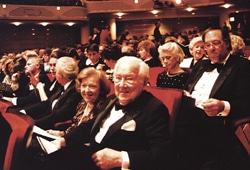
Raymond F. Kravis was a prominent geologist and philanthropist from Tulsa, Oklahoma, who wintered in Palm Beach for more than 35 years. In 1985, a consortium of his friends donated more than $7 million to name the facility for Mr. Kravis.
Architect
Eberhard Zeidler, principal partner in the firm of Zeidler-Roberts Partnership of Toronto, Ontario. Other major works include the World Trade Center and Liberty Place One in Philadelphia.
Acoustician
Russell Johnson/Artec Consultants, New York. Major works include Symphony Hall in Birmingham, England and the Morton Meyerson Symphony Center in Dallas, Texas.
Contractor
Blount, Inc. of Montgomery, Alabama. Other major works include the Louisiana Superdome and the reconstruction of Kuwait following the Gulf War.
Board Officers
Alexander W. Dreyfoos, Jr. – Chairman
Robert M. Montgomery, Jr. – Vice Chairman
Shannon R. Ginn – Second Vice Chairman
Merrill L. Bank – Treasurer
Robert S. Puder – Associate Treasurer
Judith B. Goodman – Secretary
Honorary Artistic Board
Mikhail Baryshnikov
Peter Martins
Itzhak Perlman
Andre Watts
Pinchas Zukerman

